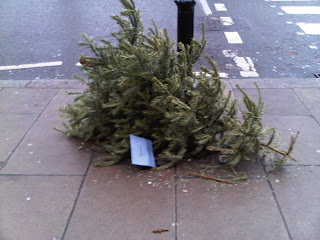
As hinted already in these pages, there were surprises good and bad over the holiday season. This is inevitable if you palm experiments off on guests instead of offering them someting tried and tested. Sorry to say we just like living dangerously. We learned that you have to have several alternatives up your sleeve though and this time, we needed them.
So here's the balance sheet:
Credit
L'Albore Spergola (see Blog entry)
Simonutti Pineau d'Aunis 2008
Biddenden Dornfelder 2009
Tbilvino Khvanchkara 2007
Strohmeier Blauer Wildbacher Lestoa Rot
Strohmeier Blauer Wildbacher Lestoa Rose
Col Sandago Blauer Wildbacher 2005
Margaretenhof Dornfelder 2006
Ch. Haut Chaigneau Lalande de Pomerol 1999
Bean & Beluga White
DebitC'a Bruzzo, Tocai Rosso 2008
Domaine Grisard Cuvee Persan 2009
Niepoort Palomino
Hatzidakis Voudomato 2008
Strohmeier Rose
Bartucci Bugey Cerdon Sparkling Rose
Grafen Neipperg Schwarzriesling 2009
Bean & Beluga Red
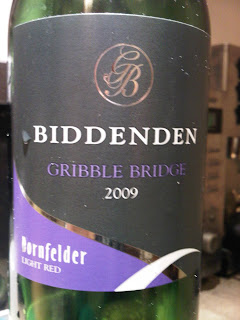
Concerning the successes, the Biddenden Gribble Ridge Dornfelder was outstanding. The first English red we have ever had of which a case would be welcome. The Tbilvino was a semi-sweet blend of two varieties unknown to us: Aleksandrouli and Mujuretuli. This was first brought to our attention by the 24 year old Georgian Verdi baritone Mikheil Kiria who told us that Kvanchkara was the best Georgian wine.

Here he is outside the Louvre (he's the one in the foreground).

We were told it resembled more a luscious New World red than a sweet wine as such and that description was quite right. We drank it as a Vino da Meditazione rather than with food which nonetheless would have been possible.

Blauer Wildbacher was the standout successful variety of the season. Even the Italian version from the Colli Trevigiani was excellent.
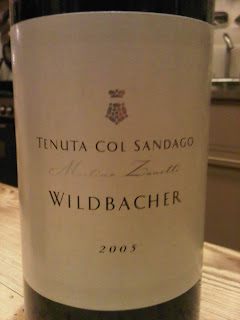
The Margaretenhof Rheinhessen Dornfelder was the house wine of the cafe at Dresden Airport
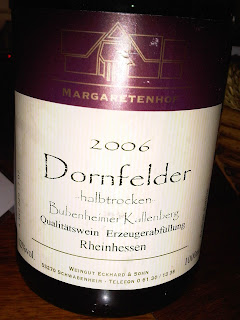
but that didn't prevent it from being delicious. Together with Blauer Wildbacher, Dornfelder really shone in these days.
As you see, we are already strayng into our German trip in the first days of January (of which more later) and here we list a wine which was given to us and not one we had bought in for the obscurty of its grapes. This was the phenominal Chateau Haut Chaigneau -
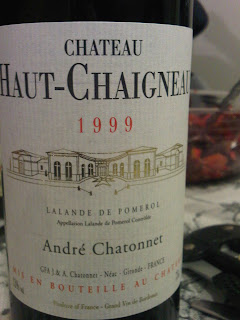
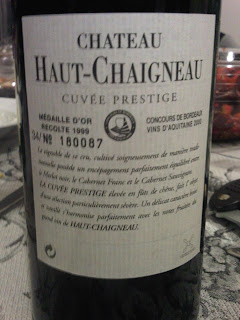
not only the very best Lalande de Pomerol we have ever tasted but in fact the very first really good one. All previous examples we had ever tasted had been disappointments to the extent that we had quite given up on this rather unloved Appellation. It just goes to show how things have improved in Bordeaux over the years. We believe there are such things as a good Cotes de Bourg or Blaye and even drinkable Boreaux Superieurs and plain Bordeaux!
The White Cuvee we tasted at the Semperoper bar was made by a new Gastronomie in Dresden called "Bean and Beluga" (geddit?) from local white varieties whch were explained to us but which we have forgotten. They may have included Goldriesling. At under 12%, this was excellent. Unfortunately their Red blend was not as successful, containing the first German Cabernet Sauvignon to pass our lips together with Merlot. This was 14% and didn't bode well for German Cabernet Sauvignons for which there is apparently something of a mode.
The other disappointments need some explanation because some of these wines have been highly praised in this blog. The C'a Bruzzo Tocai Rosso and Grisard Persan are both different vintages from those we were so happy to discover and we may not have given these particular wines enough time to breathe or may not even have stored correctly. The Niepoort Palomino definitely tasted oxidised or maybe we should say '
rancio'. We're not sure if that is how this sherry grape is meant to be or if it was just as a result of having been stored too long in our rather warm cellar.
Real disappointment came with the Hatzidakis Voudomato.
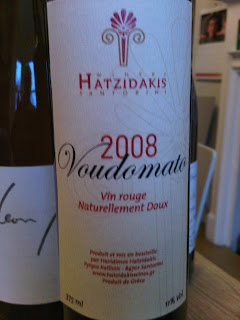
They warned us it was sweet but the sweetness of this beverage was such as to make it consumable only by dribbling it over Vanilla icecream. Our 50cl bottle sits on top of the fridge awaiting the odd occasion when it can be used. This may not come for a while! A pity because the vines are not only from the uber-obscure Voudomato variety but are said to be the world's most ancient at 500 years old.
Strohmeier's Rose was their only non-Blauer Wildbacher wine we tasted. It was a perfectly acceptable Schilcher but nothing as interesting as ther Lestoa Rose (made from Blauer Wildbacher).
We have enjoyed Grafen Neipperg's Schwarzriesling (Pinot Meunier) in the past but maybe 2009 was not a great year for this grape or perhaps it needed more bottle age.

Nothing wrong with the Bugey Cerdon Rose - just that we didn't realise it was Demi-Sec which was our fault because we
were aware it was 8% alcohol - the same as wines like Moscato frizzante or Asti Spumante. That kind of thing is liable to get you into trouble when guests arrive and you offer them a sweet sparkling wine as an aperitif.

 Shandong Province, China and the C’a Bruzzo Tocai Rosso Vigna Veccia with votes both for and against. The Croatian Babic wasn’t much liked but there were some surprise standouts with the Dutch Colonjes Johanniter leading the way.
Shandong Province, China and the C’a Bruzzo Tocai Rosso Vigna Veccia with votes both for and against. The Croatian Babic wasn’t much liked but there were some surprise standouts with the Dutch Colonjes Johanniter leading the way.